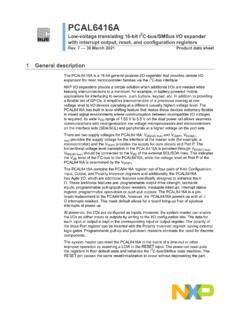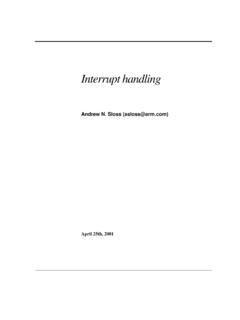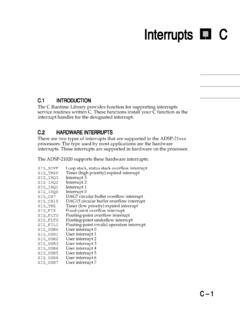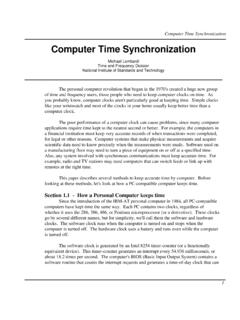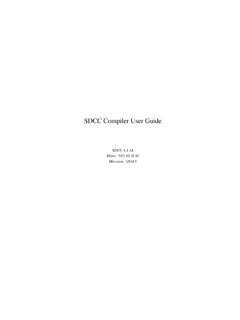Transcription of Section 8. Interrupts - Microchip Technology
1 M. Section 8. Interrupts HIGHLIGHTS. This Section of the manual contains the following major topics: Introduction ..8-2. Control Registers ..8-5. Interrupt Latency ..8-10. INT and External Context Saving During Interrupts ..8-11. Initialization ..8-14. Design Tips ..8-16. Related Application Revision History ..8-18. 8. Interrupts 1997 Microchip Technology Inc. DS31008A page 8-1. PICmicro MID-RANGE MCU FAMILY. Introduction PICmicro MCUs can have many sources of interrupt. These sources generally include one inter - rupt source for each peripheral module, though some modules may generate multiple Interrupts (such as the USART module).
2 The current Interrupts are: INT Pin Interrupt (external interrupt). TMR0 Overflow Interrupt PORTB Change Interrupt (pins RB7:RB4). Comparator Change Interrupt Parallel Slave Port Interrupt USART Interrupts Receive Interrupt Transmit Interrupt A/D Conversion Complete Interrupt LCD Interrupt. Data EEPROM Write Complete Interrupt Timer1 Overflow Interrupt Timer2 Overflow Interrupt CCP Interrupt SSP Interrupt There is a minimum of one register used in the control and status of the Interrupts . This register is: INTCON.
3 Additionally, if the device has peripheral Interrupts , then it will have registers to enable the periph- eral Interrupts and registers to hold the interrupt flag bits. Depending on the device, the registers are: PIE1. PIR1. PIE2. PIR2. We will generically refer to these registers as PIR and PIE. If future devices provide more inter - rupt sources, they will be supported by additional register pairs, such as PIR3 and PIE3. the interrupt Control Register, INTCON, records individual flag bits for core interrupt requests.
4 It also has various individual enable bits and the global interrupt enable bit. DS31008A-page 8-2 1997 Microchip Technology Inc. Section 8. Interrupts The Global Interrupt Enable bit, GIE (INTCON<7>), enables (if set) all un-masked Interrupts or disables (if cleared) all Interrupts . Individual Interrupts can be disabled through their correspond- ing enable bits in the INTCON register. The GIE bit is cleared on reset. The return from interrupt instruction, RETFIE, exits the interrupt routine as well as sets the GIE.
5 Bit, which allows any pending interrupt to execute. The INTCON register contains these Interrupts : INT Pin Interrupt, the RB Port Change Interrupt, and the TMR0 Overflow Interrupt. The INTCON register also contains the Peripheral Interrupt Enable bit, PEIE. The PEIE bit will enable/disable the peripheral Interrupts from vectoring when the PEIE bit is set/cleared. When an interrupt is responded to, the GIE bit is cleared to disable any further interrupt, the return address is pushed into the stack and the PC is loaded with 0004h.
6 Once in the interrupt service routine the source(s) of the interrupt can be determined by polling the interrupt flag bits. Generally the interrupt flag bit(s) must be cleared in software before re-enabling the global inter - rupt to avoid recursive Interrupts . Once in the interrupt service routine the source(s) of the interrupt can be determined by polling the interrupt flag bits. Individual interrupt flag bits are set regardless of the status of their corresponding mask bit or the GIE bit. Note 1: Individual interrupt flag bits are set regardless of the status of their corresponding mask bit or the GIE bit.
7 Note 2: When an instruction that clears the GIE bit is executed, any Interrupts that were pending for execution in the next cycle are ignored. The CPU will execute a NOP in the cycle immediately following the instruction which clears the GIE bit. The inter - rupts which were ignored are still pending to be serviced when the GIE bit is set again. 8. Interrupts 1997 Microchip Technology Inc. DS31008A-page 8-3. PICmicro MID-RANGE MCU FAMILY. Figure 8-1: Interrupt Logic PIR/PIE Registers INTCON Register ADCIF.
8 ADCIE. ADIF. ADIE. CCP1IF. CCP1IE. CCP2IF. CCP2IE. GPIF. CMIF. GPIE. CMIE Wake-up (If in SLEEP mode). INTF. EEIF INTE. EEIE. RBIF. RBIE. Interrupt to CPU. T0IF Clear GIE bit LCDIF T0IE. LCDIE. OVFIF PEIE. OVFIE (EEIE 2). (ADIE 2). PBIF. PBIE. GIE. PSPIF. PSPIE. RCIF. RCIE. SSPIF. SSPIE Note 1: This shows all current Interrupt bits (at time of manual printing) for TMR1IF all PICmicro Mid-Range MCUs. Which bits pertain to a specific TMR1IE device is dependent upon the device type and peripherals imple- mented.
9 See specific device data sheet. TMR2IF. TMR2IE. 2: Some of the original Mid-Range devices had only one peripheral module. These devices do not have the PEIE bit, and have the mod- TXIF. ule enable bit in the INTCON register. TXIE. DS31008A-page 8-4 1997 Microchip Technology Inc. Section 8. Interrupts Control Registers Generally devices have a minimum of three registers associated with Interrupts . The INTCON. register which contains Global Interrupt Enable bit, GIE, as well as the Peripheral Interrupt Enable bit, PEIE, and the PIE / PIR register pair which enable the peripheral Interrupts and dis- play the interrupt flag status.
10 INTCON Register The INTCON Register is a readable and writable register which contains various enable and flag bits. Note: Interrupt flag bits get set when an interrupt condition occurs regardless of the state of its corresponding enable bit or the global enable bit, GIE (INTCON<7>).This feature allows for software polling. Register 8-1: INTCON Register R/W-0 R/W-0 R/W-0 R/W-0 R/W-0 R/W-0 R/W-0 R/W-0. GIE PEIE (3) T0IE INTE (2) RBIE (1, T0IF INTF (2) RBIF (1, 2). 2). bit 7 bit 0. bit 7 GIE: Global Interrupt Enable bit 1 = Enables all un-masked Interrupts 0 = Disables all Interrupts bit 6 PEIE: Peripheral Interrupt Enable bit 8.











